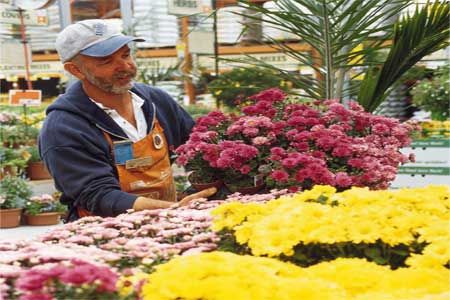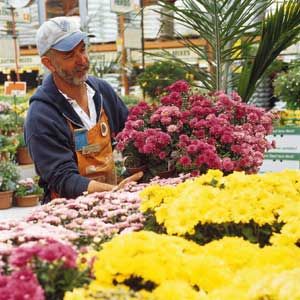
One of my favorite jobs when I worked at my family’s greenhouse and nursery in upstate New York was to size up the competition.
I would pull a hat down low over my eyes and drive from nursery to nursery to squeeze root balls, search for signs of insects and diseases and, of course, compare prices. Sometimes I would even order plants from catalogs just to get an idea of what was available.
Now I’m on the other side of the cash register and shop for plants with my own money. I’ve learned what to buy — and what not to buy — and where to shop. Here’s what my experience has taught me about local nurseries, home centers, discount stores, mail-order catalogs and online retailers.
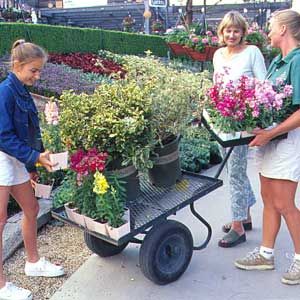
At the Nursery
Whenever I need information on plants, a local nursery is the best place to start. Here I can talk with an expert, especially important when I’m looking for large and expensive tress and shrubs. Some nurseries have display gardens that give an idea of how the plants look as they mature.
Nurseries are also the best place to buy unusual annuals and perennials. I always buy my vegetable plants from nurseries because they have a good selection of varieties that do best in my local climate.
But nurseries charge more than other retailers. My local nursery here in Vermont gets $2.39 for a pack of common annuals like impatiens and $16 for a flat of eight-packs. They charge $3.99 for a 4-in. potted perennial. Not too bad for a nursery but still 30 to 100 percent higher than my local home center. But for in-depth advice, plant variety and service, nurseries earn their markup.
Follow these rules to get the most for your money at a nursery:
Make friends.
Get to know employees or even the owners. They’ll tell you what has been growing well for them and what hasn’t. They may even clue you in on upcoming sales, or offer a discount. When shopping at a small nursery, ask questions, solicit suggestions, explain your landscape situation. You pay for service, so take advantage of it.
Be patient.
Unless you’re in a hurry to plant, it pays to wait for sales. In June, my local nursery holds an “All you can carry for $10 sale.”
Examine the merchandise.
Find a nursery with a low-pressure, no-hassle attitude, where they will let you take time to find the very best plants.
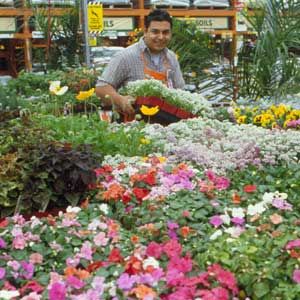
Back in the days when I worked at the family nursery, big discount stores had a bad reputation when it came to plant quality. And rightly so. But things have changed, and you can find good plants at these places if you shop carefully — and fast. One of the reasons for the improved quality is that many home centers now carry branded plants, such as Proven Winners, Blooms of Bressingham and Hines. These growers use top varieties and grow them under exacting conditions, so the quality is uniformly excellent.
Home centers are the place to shop for large quantities of common annuals and perennials, as well as for small landscape plants. You can’t beat the prices. My local Home Depot sells annuals for $1.84 for a six-pack, or $7.99 for a half-flat of 21 plants. That’s 30 to 40 cents per plant. Perennials often go for $1.99 in a 4-in. pot. You can also find junipers and arborvitae in 1-gal. containers for as little as $4.99. These plants usually cost two to three times as much at nurseries.
Still, plants don’t get top-notch care at these places, according to landscape designer Ann Whitman. The author of Organic Gardening for Dummies (Hungry Minds, 2001), she spent some time in the trenches working in the nursery department for a large national home center. Here are her tips for plant shopping at home centers:
Be there when the truck arrives.
This is the best way to get a good selection, and the only way you can be sure the plants are fresh, well watered and well tended. “There’s a schedule in every store that notes when the trucks will arrive and what they will be carrying,” Whitman says. “Ask an employee to check it for you.” If deliveries are made when the store is closed, try to be the first in line when it opens.
Shop during the week.
“It’s like a zoo at home centers on the weekends,” Whitman says. “On a typical spring weekend they will sell an entire tractor-trailer load of trees and shrubs.” So shop on a Thursday or Friday or first thing Saturday morning.
Be decisive. “If you see a plant you like, buy it right then because it won’t be there the next time you go,” she says.
Don’t buy leftovers.
On the flip side, if you see a plant that was there during your last visit, pass on it. Anything that has been sitting around or off in a corner is not worth buying. “They barely even water the plants,” Whitman says. “Their philosophy is ?turn and burn.’ It’s cheaper to throw things out than to maintain them.” Even though some home center nursery employees are schooled in horticulture, they just don’t have time to do maintenance.
Make a deal.
Whitman says there are bargains to be had at the end of the season. “They clear everything out before the Christmas trees come in, so ask them if they want to make a deal.” She has heard stories of customers buying everything on the lot for $100.
In short, it is difficult to fight the crowds at these stores and it might be hard to find someone to answer your questions, but you can’t beat the prices.

On the Web or By Catalog
If there’s a plant that I must have, chances are I can find it online or in a mail-order catalog. Both of these sources offer a huge selection and convenience. It’s the best way to buy fruit trees and some shrubs, especially roses. Most local nurseries and home centers just don’t offer as many varieties of those plants. And the prices are usually comparable to those charged by nurseries, although costs can vary greatly. When I checked five different places for a price on a 4-in. purple cone flower (Echinacea), I found five different prices, ranging from $3.00 to $7.99. Annuals are usually prohibitively expensive online or in catalogs — as much as a buck a plant. And the quality is dicey as well.
But there are deals out there. I found a 2-gal. dwarf holly selling for $29.99 at the local nursery. I’ve seen the same plants, albeit smaller, for $18.99 via mail order. Even with shipping, the cost for these shrubs beats the price at nurseries. Factor in a quantity discount if you’re buying a bunch, and they are considerably cheaper.
Shopping from catalogs or online, though, is more of a gamble than shopping at a nursery because you can’t examine the plants. When they arrive, the plants always seem to be smaller than what you imagined when ordering. Fortunately, they usually catch up in size with nursery plants.
Steve Frowine, director of horticulture for Etera, a wholesale nursery, says the problem is that there’s no industry standard for plants. Frowine has also worked for Burpee and White Flower Farm, and he ran his own mail-order nursery company. Plants are normally sold by pot size, he notes, “But a plant advertised as growing in a 4-in. pot may have been growing in that pot long enough to become root-bound, or it may have just been transplanted into it and have hardly any roots. If you’re buying sight unseen there’s no way you can know.”
Find a familiar name. Frowine recommends finding a company you trust. If you need help, talk to friends and neighbors. Or check on the Web for ratings of mail-order nurseries, such as “The Plants by Mail FAQ” at www.plantsbymail.net. Study the site or catalog carefully. The content will offer you a clue to the reliability and professionalism of the company. Every plant listing should include the complete botanical name, hardiness information and, with any luck, a good picture. The catalog or site should indicate whether the plant is shipped bare-root or in a container and include specific shipping information. You don’t want a tender plant to arrive while the ground is still frozen solid.
Get a guarantee. Make sure the company stands behind its plants and offers to replace those that don’t survive shipping and transplanting. Don’t settle for a wishy-washy “guarantee” such as “We will do our best to satisfy you.”
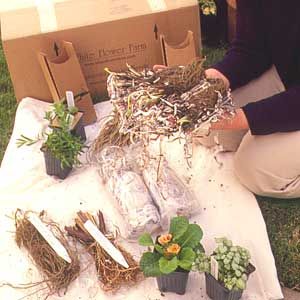
PICKING THE BEST PLANT IN THE BUNCH
Annuals and Vegetable Plants
- Think small. Short stocky plants will survive transplanting better than tall, lanky ones.
- For the same reason, it’s best to select plants that are slightly underfed.
- Pass over those in full bloom. Better to choose plants that are still putting energy into leaf and root growth. They will grow better after transplanting and will bloom more in the long run.
- Check the roots. Peek through the drainage holes. Look for a light-colored root mass in the soil, but there shouldn’t be enough roots to completely fill the pack.
- Count the plants in the plastic tray. You’d be surprised at the number of people who walk out of the nursery a few plants short of a full pack. If there’s a blank, that means a plant has died, probably from disease or poor care.
Potted Perennials
- Check the roots and make sure they’re not wound around each other. You don’t want a perennial that has been kept in the same pot for more than one season. Crowded and root-bound, they won’t thrive when transplanted to the garden.
- Examine top growth carefully. You should see more green than brown. A woody plant is an old plant. Be wary of plants that have died back in the center. That means they’ve gone too long without being divided.
- Check the rules for “Annuals and Vegetable Plants” — most apply to potted perennials as well.
Tree and Shrubs
Spending $1.90 for pack of petunias is one thing, but when you drop $100 or more for a tree or shrub, you’d better be sure it’s in good shape.
- Check the trunk and branches. Look for nicks or cuts in the bark. They are signs of rough treatment and possible entry points for insects and disease. Thin and weak branches or those with black tips indicate poor care, especially too little or too much water. If most of the leaves have spots or streaks, it is a sign of disease or a nutrient imbalance.
- Examine the roots. Carefully remove the plant from its container or, better
- yet, have an employee do it for you. You should see a thick mass of light-colored fibrous roots throughout the soil. But if the roots are thick, brown and wrapped around each other, the plant is root-bound. Its growth will be restricted, and you shouldn’t buy it. On the other hand, if you see more soil than roots, or if the soil falls away from the roots, that means it’s only been recently potted. It might not have enough roots to survive transplanting. Pass on that plant as well.
- Keep your eye on the “ball.” You don’t see as many balled-and-burlapped plants as you once did, but some nurseries still sell them. You can’t unwrap the roots at the store, but if the wrapping is ripped or torn, the roots inside could be damaged. Gently squeeze the root ball — you should be able to feel a firm root mass inside. If the burlap feels soft and empty, this may also be a bare-root plant that was recently packaged. Again, it may not have enough healthy roots to withstand transplant shock.
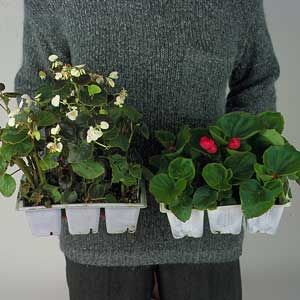
Where to Find It
Cindi’s Catalog of Garden Catalogs
Mailorder Gardening Association
Gardening by Mail: A Source Book, by Barbara J. Barton; Houghton Mifflin Co., Boston, 1997; $24.
